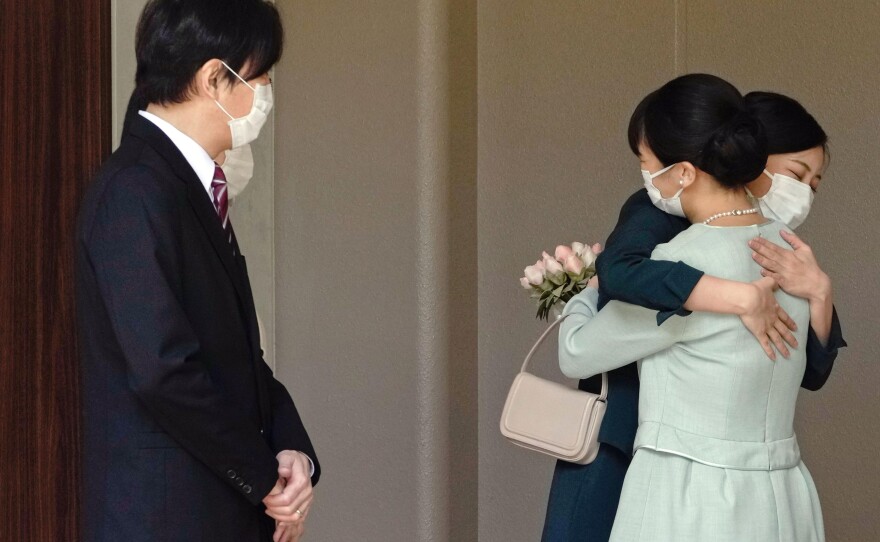Updated October 26, 2021 at 9:28 AM ET
Japan's Princess Mako tied the knot with a commoner and exited Japan's royalty in a marriage that has raised issues of how modern-day Japanese royals are expected to behave, as well as gender equality and human rights in the world's oldest continuous monarchy.
The controversy delayed the marriage by three years. It prompted the pair to skip any formal ceremony, instead just registering their union at a local government office on Tuesday.
And due to concerns that a controversial marriage might benefit from taxpayer money, the princess declined the usual payment of about $1.3 million to women who are required by law to leave Japan's royal family after marrying a commoner.
Princess Mako became Mako Komuro, taking the surname of her husband, Kei Komuro. Both are 30 years old. The former princess is the eldest of two daughters of the Crown Prince Fumihito and is the niece of Emperor Naruhito.

Kei Komuro returned in September from New York, where he works in a law firm, took the state bar exam and received a law degree from Fordham University Law School. The pair plan to relocate to New York.
After registering their marriage, the couple delivered prepared remarks and then distributed written answers to five questions submitted in advance by media.
The Imperial Household Agency said the format was decided at the last minute, due in part to Mako's shock at learning that "some of the questions included false information being presented as truth," the Kyodo News Agency quoted the Imperial Household Agency as saying.
Thanking supporters and hitting back at critics, Mako said: "I felt fearful, pained and sad that incorrect information was taken as truth, and that these baseless stories spread."
She didn't specify what the stories were, but much of the controversy is centered on a financial dispute over about $35,000 between groom Kei Komuro's mother and her former fiancé.
The presser "gave the impression that the couple only insisted on their own validity and didn't answer questions which were inconvenient for them," commented Takeshi Hara, an expert on Japan's imperial system at the Open University of Japan.
Romance is a fairly recent factor for Japan's royals
A recent poll by the Mainichi Shimbun newspaper found 38% of respondents support the marriage, while 35% oppose it.
Those in the 35%, says Ken Ruoff, Portland State University historian and author of Japan's Imperial House in the Postwar Era, 1945-2019, "might do well to read their constitution, which very clearly provides all Japanese with the right to choose their spouse."
But historically speaking, the will of the men and women to be married didn't really enter into the picture until the late 19th and early 20th century, notes Takeshi Hara, before which royal marriages were arranged without regard for such matters.
The first postwar emperor, Akihito, and his wife, Empress Michiko, carved out a new role, centered on showing concern for the weal and woe of the common folk, which Hara says they did in two ways.
"One was to pray for the peace and happiness of the people," he says. "The other was to visit the actual places people live, stand beside them and talk to them."
Mako's decision to put her private life before her public one, he adds, appears to have rubbed some citizens the wrong way.
Akihito and Michiko, he says, "established something like a norm for how royal family members should behave, and it became a heavy burden on the members of next generation."
There are only three heirs to the throne
With Mako's departure, Japan's royal family is down to 17 members, compared to 67 in 1945, and only three heirs to the throne. Japan remains one of the few monarchies where women are banned from inheriting the throne, although it has had eight female rulers in its history. Japan's emperors trace their lineage to the Shinto Goddess of the Sun, Amaterasu.
Proposals to change the law and allow women to ascend the throne have been opposed by conservatives, including politicians of the ruling Liberal Democratic Party.
While the emperor's role is a symbolic one, Portland State's Ken Ruoff notes, it's a symbol that matters. "I think, unfortunately, it says a lot about the stickiness of patriarchy in Japan that the national symbol is still limited to males."
Mako's departure from the royal family has occasioned many comparisons to the "Megxit" of Britain's Prince Harry and Meghan Markle. Ruoff says one similarity is that many royals who are not in line to the throne may increasingly see royalty as an unattractive deal.
"It just doesn't seem worth it to some of the lesser royals," he says, "to put up with the strict restraints on their lives, considering how little return they get for it."
Copyright 2021 NPR. To see more, visit https://www.npr.org. 9(MDAzMjM2NDYzMDEyMzc1Njk5NjAxNzY3OQ001))







